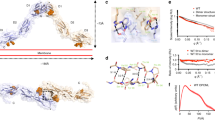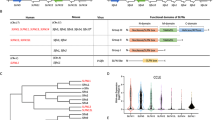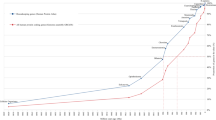Abstract
We have recently identified the TSLC1 gene as a novel tumor suppressor in human non-small cell lung cancers. TSLC1 encodes a membrane glycoprotein with an extracellular domain homologous to those of immunoglobulin superfamily proteins. Truncation of TSLC1 in the cytoplasmic domain in a primary human tumor suggests that this domain is important for tumor suppressor activity. Here, we report the isolation of two TSLC1-like genes, TSLL1 and TSLL2, based on their structural homology with the sequences corresponding to the cytoplasmic domain of TSLC1. Significant similarity was also observed in the extracellular domain as well as in the overall gene structure, indicating that these three genes form a unique subfamily (the TSLC1-gene family) in the immunoglobulin superfamily genes. In contrast to the ubiquitous expression of TSLC1, TSLL1 is expressed exclusively in adult and fetal human brain, while TSLL2 is expressed in several specific tissues including prostate, brain, kidney and some other organs. Expression of TSLL1 and TSLL2 was lost or markedly reduced in many human glioma cell lines or some prostate cancer cell lines, suggesting that loss of expression of these genes might be involved in some human cancers.
This is a preview of subscription content, access via your institution
Access options
Subscribe to this journal
Receive 50 print issues and online access
$259.00 per year
only $5.18 per issue
Buy this article
- Purchase on Springer Link
- Instant access to full article PDF
Prices may be subject to local taxes which are calculated during checkout






Similar content being viewed by others
References
Antequera F, Bird A . 1993 Proc. Natl. Acad. Sci. USA 90: 11995–11999
Baumgartner S, Littleton JT, Broadie K, Bhat MA, Harbecke R, Lengyel JA, Chiquet-Ehrismann R, Prokop A, Bellen HJ . 1996 Cell 87: 1059–1068
Bicher A, Ault K, Kimmelman A, Gershenson D, Reed E, Liang B . 1997 Gynecol. Oncol. 66: 36–40
Debiec-Rychter M, Alwasiak J, Liberski PP, Nedoszytko B, Babinska M, Mrozek K, Imielinski B, Borowska-Lehman J, Limon J . 1995 Cancer Genet. Cytogenet. 85: 61–67
Funayama N, Nagafuchi A, Sato N, Tsukita S, Tsukita S . 1991 J. Cell. Biol. 115: 1039–1048
Kozak M . 1989 J. Cell. Biol. 108: 229–241
Kuramochi M, Fukuhara H, Nobukuni T, Kanbe T, Maruyama T, Ghosh HP, Pletcher M, Isomura M, Onizuka M, Kitamura M, Sekiya T, Reeves RH, Murakami Y . 2001 Nat. Genet. 27: 427–430
Marfatia SM, Leu RA, Branton D, Chishti AH . 1995 J. Biol. Chem. 270: 715–719
Marfatia SM, Morais-Cabral JH, Kim AC, Byron O, Chishti AH . 1997 J. Biol. Chem. 272: 24191–24197
Martin M, Andreoli C, Sahuquet A, Montcourrier P, Algrain M, Mangeat P . 1995 J. Cell. Biol. 128: 1081–1093
Nishizaki T, Ozaki S, Harada K, Ito H, Arai H, Beppu T, Sasaki K . 1998 Genes Chromosomes Cancer 21: 340–346
Pinkel D, Straume T, Gray JW . 1986 Proc. Natl. Acad. Sci. USA 83: 2934–2938
Poliak S, Gollan L, Martinez R, Custer A, Einheber S, Salzer JL, Trimmer JS, Shrager P, Peles E . 1999 Neuron 24: 1037–1047
Rosenberg JE, Lisle DK, Burwick JA, Ueki K, von Deimling A, Mohrenweiser HW, Louis DN . 1996 Oncogene 13: 2483–2485
Shimura M, Onozuka Y, Yamaguchi T, Hatake K, Takaku F, Ishizaka Y . 1999 Cancer Res. 59: 2259–2264
Smith JS, Alderete B, Minn Y, Borell TJ, Perry A, Mohapatra G, Hosek SM, Kimmel D, O'Fallon J, Yates A, Feuerstein BG, Burger PC, Scheithauer BW, Jenkins RB . 1999 Oncogene 18: 4144–4152
Songyang Z, Fanning AS, Fu C, Xu J, Marfatia SM, Chishti AH, Crompton A, Chan AC, Anderson JM, Cantley LC . 1997 Science 275: 73–77
Acknowledgements
We thank Machiko Watanabe for laboratory assistance. This work was supported in part by a Grant-in-Aid for the Second Comprehensive 10-Year Strategy for Cancer Control from the Ministry of Health and Welfare, Japan and by a Grant-in-Aid for Special Projects for Cancer Research from the Ministry of Education, Science, Sports, and Culture of Japan. H Fukuhara, M Kuramochi, T Nobukuni, T Fukami and M Saino are recipients of Research Resident Fellowships from the Foundation for Promotion of Cancer Research of Japan.
Author information
Authors and Affiliations
Corresponding author
Rights and permissions
About this article
Cite this article
Fukuhara, H., Kuramochi, M., Nobukuni, T. et al. Isolation of the TSLL1 and TSLL2 genes, members of the tumor suppressor TSLC1 gene family encoding transmembrane proteins. Oncogene 20, 5401–5407 (2001). https://doi.org/10.1038/sj.onc.1204696
Received:
Revised:
Accepted:
Published:
Issue Date:
DOI: https://doi.org/10.1038/sj.onc.1204696
Keywords
This article is cited by
-
SynCAMs in Normal Vertebrate Neural Development and Neuropsychiatric Disorders: from the Perspective of the OCAs
Molecular Neurobiology (2024)
-
Overlapping morphological, immunohistochemical and genetic features of superficial CD34-positive fibroblastic tumor and PRDM10-rearranged soft tissue tumor
Modern Pathology (2022)
-
Tracing the evolution of nectin and nectin-like cell adhesion molecules
Scientific Reports (2020)
-
Nectin-like molecule-4/cell adhesion molecule 4 inhibits the ligand-induced dimerization of ErbB3 with ErbB2
Scientific Reports (2017)
-
Generation of a monoclonal antibody specific to a new candidate tumor suppressor, cell adhesion molecule 2
Tumor Biology (2014)



